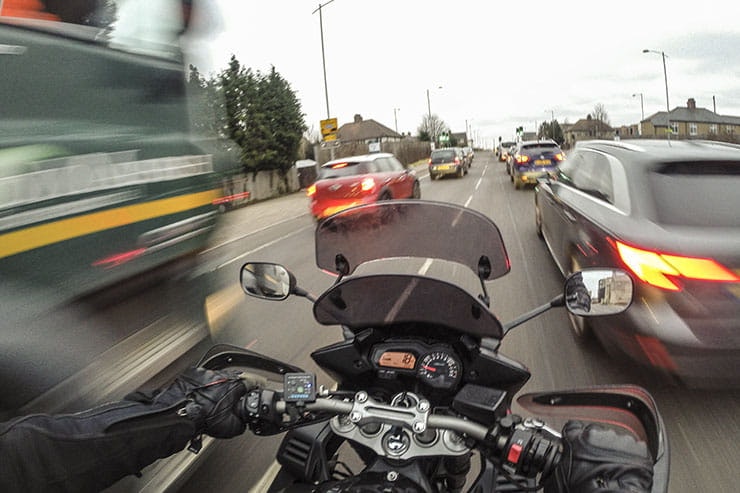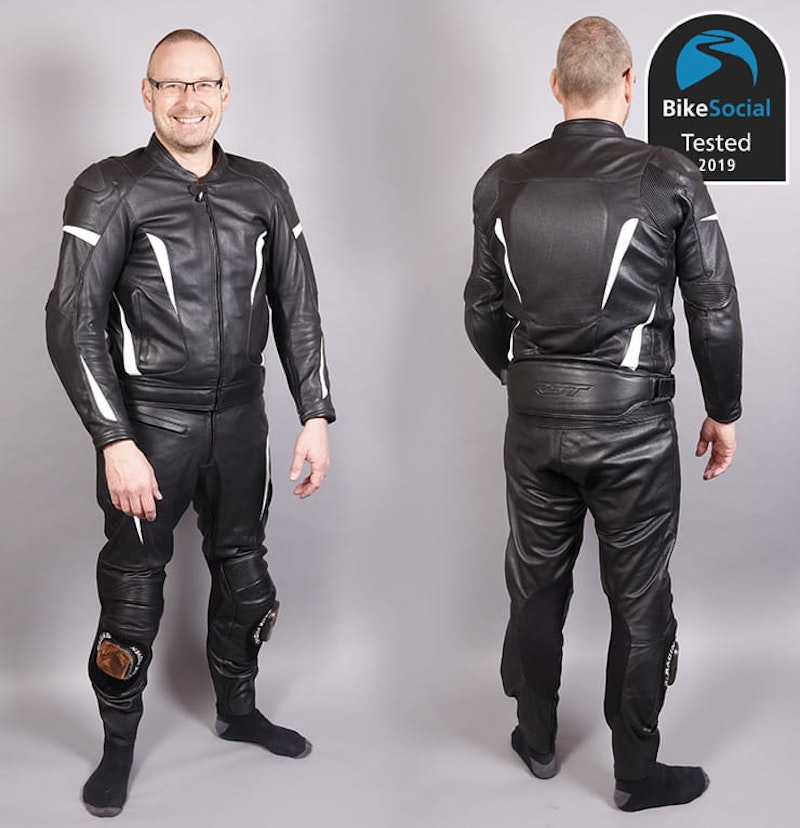Ten simple tips to survive your first month on a bike
By Steve Rose
BikeSocial Publisher
02.03.2021
‘Sorry I’m early, I came by bike.’ Congratulations, you finally did it and got yourself on two wheels.
CBT certificate in hand, your first bike bought, some kit too and the joyful realisation that never again will you arrive at work an hour late, having spent 105 minutes with your nose in a stranger’s armpit.
Commuting by motorcycle is life-changing. But like anything new it takes time to get the hang of it. No one becomes an accomplished pianist, horse rider, scuba diver or ski jumper in the first two weeks and commuting on a motorcycle is no different.
Riding a bike in busy traffic is like three-dimensional chess. Think ahead, looking 200 metres into the distance, judging the speed, direction and angles of the moving traffic. Searching out a gap where you and your bike will exist for a second-or-two before moving slickly into the next one. You are no longer part of the same journey as the hundred queuing vehicles ahead. You are master of your own independent adventure in the personal ‘motorcycle lane’ you carve out for yourself. Wow.
And when you put it like that, you can see why it takes a little time to get the knack. Fortunately, there are some simple tips and tricks that will make the process easier.
Get the fit right with your motorcycle clothing
Riding a motorcycle at 50mph into a 20mph winter headwind in the rain is like standing in front of a pressure washer using only the cold tap. Without the right kit you’ll be soaked and shivering in a matter of seconds. Thankfully, most modern bike clothing (even the relatively budget stuff) is good enough to keep you warm and dry for an hour’s commute, but only if you use it properly.
Spending some time getting the best fit for your kit is very worthwhile. As is learning to take the visor off your helmet so you can clean it regularly. The two most common mistakes are not getting a snug fit around you collar and wearing your gloves over the cuffs of your jacket.
In cold weather we lose huge amounts of heat from our neck. Buy yourself a thin neck tube and use it every day. Not only will it keep you disproportionately (for its size and cost) warm, but it also helps you to get a good seal between your jacket collar and your neck without chafing. And in summer it stops wasps headbutting your adam’s apple while doubling as a bandana when you forget your hat (again). An extra fifteen seconds getting a snug fit here will work wonders halfway around the A406 on a November morning.
Putting gloves underneath cuffs sounds counter-intuitive, like the water will run up your sleeves. But it doesn’t. Doing it this way keeps the water out for hours. Gloves over cuffs allows the rain that hits your arms to dribble down into your gloves giving you cold, wet wrinkly pinkies in a matter of minutes.
Don’t forget to check BikeSocial’s kit reviews
Learn to read the road conditions
The obvious ones are wet and dry. The less obvious ones that matter more on two wheels than four are wet leaves in autumn, gravel, lose chippings and potholes, plus slippery diesel spilt near filling stations. On a bike the road you were on yesterday will rarely be the same if you ride it again today. Don’t be complacent. But don’t be nervous either - be aware and use your time when it rains or is slippery to practice your riding in these conditions. Be gentle with the throttle, smooth with your riding and allow a little more time when braking. Get your braking done before you lean into a corner and avoid wet manhole covers. A little time spent gaining confidence now will make the next 35 years even more fun.
Make yourself visible
The most common bike accident in urban motorcycling is being hit by a car driver pulling out of a junction. ‘Sorry-mate-I-didn’t-see-you’ (SMIDSY). Viewed from the front in a busy urban environment a motorcycle is small and car drivers, easily distracted by their phone, radio, sandwich, or finely balanced coffee are rarely paying enough attention. So, it’s up to you to.
Be aware of the risks around you and read the road to look out for junctions or cars pulling away from the kerb.
Anticipate their actions, make eye contact (but still don’t assume they’ve seen you) and always be ready to take evasive action.
Away from junctions your biggest worry will be not being seen as you overtake a slow-moving vehicle. A motorcycle doing 30mph past a queue of cars doing 10mph seems to appear out of nowhere to a frustrated gridlocked motorist about to do a U-turn. Don’t be afraid to use your horn in a chirpy, friendly way to let other traffic know you are there. And remember, if you can’t see their mirrors, then they can’t see you.
Learn low speed control
Riding through slow-moving traffic involves picking a path through the gaps at almost walking pace. The skill here is balancing small amounts of throttle and clutch, like you did on the U-turn and slow-riding exercises for your CBT. Adding a small amount of rear brake too can help stabilise the bike. And the most important thing is to look where you want the bike to go (as opposed to looking at the things you are wanting to avoid). Do this and your body’s sense of balance, plus fine control of the bike will do the rest. Go to an empty carpark and practice doing very low speed riding; U-turns, figure-of-eights and coming to almost a complete halt without putting your feet down.
Practice braking
The other most common urban accident is when the car driver pulls out in front of you, the rider slams on the brakes, locks the front wheel and falls off. Motorcycle brakes are generally very good. In the dry you should use around 75/25 front:rear brake. The really important moment in motorcycle braking is the first split-second. If you panic and grab the front brake hard, the front suspension will dive dramatically, making the springs bottom-out, which then locks the front wheel and you’re off. ABS brakes (most modern bikes have them) can help here, but they can also lengthen the required stopping distance. Applying the front brake gently for the first split second helps control the suspension dive and that allows you to then pull the front brake very hard indeed and come to a controlled stop quickly.
Like the slow-speed riding, it pays to practice your braking regularly in safe conditions so that should the worst happen your fine-control is second nature.
Do your basic checks
A small capacity commuter motorcycle doesn’t have a huge amount of power, or very big tyres, or sumptuous suspension. So it’s important to make sure that what it does have is all working as well as it can be. Fifteen minutes spent checking a handful of things once a week is all it takes. Tyres should be at the correct pressure and checked to make sure you haven’t picked up a nail and the tread depth is still greater than the 1mm legal limit
The drive chain (if it has one, scooters don’t) should be correctly tensioned (see your handbook) and sprayed with chain lube. Make sure the brakes both work without excessive lever/pedal travel and there are no fluid leaks or frayed cables. And finally, check the engine oil level and top up if necessary. These simple checks will keep your bike running better, handling better and braking better, making it safer, easier to ride and worth more money when you sell it.
Read our extensive advice section on motorcycle maintenance
Ride defensively
Be confident, not aggressive. Own your space in the road. By which, we mean don’t sit in the gutter even if other traffic is quicker than you. Stay in the middle of your lane which encourages the traffic overtaking you to give you proper room without nudging you into the gutter.
Learn to look around, behind and ahead of you, all the time. Remember to do your lifesaver check before moving position in the road. At first this is tiring and occupies a lot of brain space, but it soon becomes instinctive and you aren’t even aware you are doing it.
Filtering down a line of stationary traffic is legal and easy to judge so long as you remember two things. Firstly, check for what is up ahead that’s causing the queue – if it’s a junction don’t get caught on the outside of a car turning right just in front of you. Secondly, if filtering between two lanes of traffic learn the miniscule signs that someone is about to change lane across your path. In time you develop a sixth sense for this, but while you’re learning a good tip is to only pass between two vehicles that are alongside each other – drivers can be dumb but they rarely crash into each other sideways.
Don’t get nicked for something stupid
Speeding and riding in bus lanes are the most common avoidable urban offences. There’s no need to speed in town because you gain nothing by it. Speed cameras are everywhere so you’ll be nicked by computer and they don’t accept excuses. Stick to the limit, chill out and don’t get dragged into a race.
Bus lanes are harder to judge. Some are legal for motorcycles, some are not so look for the signs and if in doubt, stay out.
Other daft offences that you’ll kick yourself for are riding with illegal tyres (no excuses), a noisy exhaust, an undersized number plate and straying into a cycle lane.
Lock it up
Motorcycles and scooters are easy to steal. Most have woeful inbuilt security and thieves simply lift them into a van or break the steering lock and wheel them away. A good quality lock and chain makes your bike far less likely to be stolen. Lock the bike to something solid (so it can’t be lifted into a van) and try to keep the lock and chain off the ground (so it can’t be broken easily).
Park in a busy place so thieves will get noticed, and try to park next to a bike with no security (so they might take that one instead), Covering it up is surprisingly effective too.
Watch how the other riders do it (and work out who is good and who is bad)
As you ride through town keep an eye out for other riders. Notice what they do and make your own judgements on whether you think it’s a smart move or not for you. A lot of what makes a great rider is universal, but some of it is improvised too. Just like skiing or horse riding or a hundred other things, getting proper additional tuition and training is worth its weight in gold.
Bonus tip…read the Highway Code again and Roadcraft – the Police riding manual. Both are packed with simple advice and tips that will make your riding better, improve your hazard awareness and increase your enjoyment on two wheels massively.

